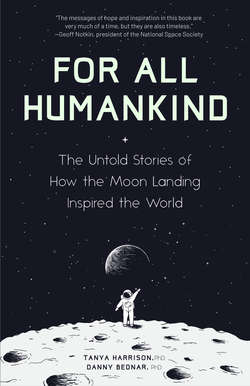Читать книгу For All Humankind - Tanya Harrison - Страница 8
На сайте Литреса книга снята с продажи.
ОглавлениеOn July 20, 1969, American astronauts Neil Armstrong and Buzz Aldrin became the first humans to set foot on a celestial body beyond Earth, while Command Module Pilot Michael Collins kept dutiful watch from orbit overhead. Set against the backdrop of the Cold War and a “space race” between the United States and the Soviet Union, this amazing achievement could have easily been touted as a win for the US, laden with patriotic messages of America being the first to land people on the Moon.
Instead, alongside the two American astronauts, Apollo 11’s Eagle lander brought messages and mementos of world peace to the lunar surface, including a stainless steel plaque that reads:
Here men from the planet Earth
first set foot upon the moon
July 1969, A. D.
We came in peace for all mankind.
Neil Armstrong also left a silicon disc on the Moon etched with microscopic goodwill messages from the leaders of seventy-three countries. Most of the messages were written in their respective native languages. In this era before computers were commonplace, some of these messages were handwritten, while others were typed. A great many of these messages call for world peace, pointing to the exploration of space as a chance for humanity to work toward something larger, together.
Even the Apollo 11 astronauts themselves recognized that their mission was far bigger. They chose not to have their names included on the mission patch—a break from NASA tradition. Michael Collins said that this choice was made so that it would be “representative of everyone who had worked toward a lunar landing.”
The mission itself wasn’t a solely American endeavor: A Canadian company built the legs for the Eagle, the two-person landing craft that carried Armstrong and Aldrin to Tranquility Base, their temporary home and landing site on the Moon. Australian radio telescopes received the live footage direct from the moon and relayed it to NASA’s Mission Control in Houston for the world to see. German rocket engineers were critical in the design of the massive Saturn V rocket for the mission.
The global impact of the Moon landing was unquestionable. An estimated 600 million people worldwide watched the landing live—nearly one-fifth of the global population at the time. During the “Giant Leap” tour after returning from the Moon, during which the three Apollo 11 astronauts toured twenty-four countries in the span of thirty-seven days, over 100 million people gathered to see astronauts in person. Countries spanning every continent, from Belarus to Malawi, Mongolia to Australia, have released stamps commemorating Apollo 11 in some way. And yet, most of the stories we hear of the Apollo 11 moon landing in popular culture are American-centric.
I wanted to hear the stories of others, to get a worldwide perspective on this momentous event in human history. This book brings together the memories of the Moon landing from eight women and men who watched the event from outside the US, including a Lithuanian holocaust survivor, a Sudanese engineer, and an Indian primary school teacher. To fully capture the representation of humanity in this historic event, we made the decision to change the wording of this book’s title from the original quote “for all mankind” to “for all humankind” so that everyone reading this will know that space is for them. Space is for everyone. We all belong to the universe, and together we can all be awed and inspired by what is possible.
Tanya Harrison
